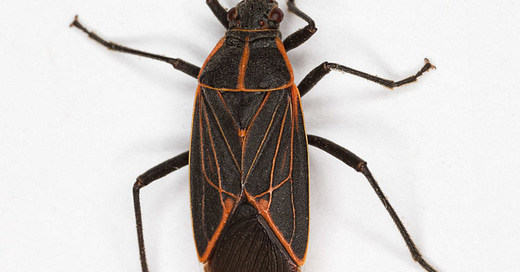It’s the time of year when I both need to and want to spend as much time outside as possible. There are endless things to do in the garden, my lawn is exploding, and every creature has put on its finest clothes. It can feel unbelievably depressing sitting in my office, the window obscured by the dark fingers of an oleander, and I often find myself distracted by plant identification, and sometimes by bug identification. I recently learned the official name for what both my wife and I grew up calling simply a “stink bug,” but which is not a stink bug at all (and I’m not sure why it has been derided as such) but rather a western boxelder bug (Boisea rubrolineata). They are almost everywhere you look where I live and where I grew up, and so I have too often taken them for granted. One of the most exciting things about learning to properly identify such common species, though, is that you have to give them real attention, and you realize how interesting even commonplace things really are.
I am absolutely fascinated by plants, but I don’t have nearly as much knowledge of them as I would like. Though I grew up in what most would consider “the country,” I never really acquired the nomenclature such an upbringing ought to have bestowed. I’ve been trying to rectify this for a number of years now, mostly by obnoxiously asking everybody around me if they know the name of this or that tree or flower, and I’m beginning to improve. I can now identify photinia and birdeye speedwell and chickweed and nandina and others. I’m stupidly proud of this given how vast that which I don’t know is. A cursory glance at a list of local plants is enough to humble me, however, and I am always cursing myself for not taking more botany classes in college. One of the problems is that it is so difficult to learn plant identification without an in-person teacher. Looking at photos is helpful, and I’ve been known to use Google photo search, but plant identification is best done outdoors with a guide who knows the plants well, like old friends, and can introduce them to you.
I find it interesting that once I have a name for something, the reality of that thing begins to assert itself more forcefully in my consciousness. This is especially the case with plants, which have a tendency to fade into the background, to be a mass of variated by mostly homogenous ornament until we begin to differentiate. I often think about this in relation to Adam’s naming the animals in Eden. He is in a sense making them real for himself, binding them in a relationship, gaining a kind of power over them, at least in the sense of knowledge. Similarly, in the ancient world a name was considered to have power—thus Odysseus’s mistake in revealing his name to Polyphemus. A name opens a connection, a relationship between two beings, and that relationship is one of knowledge but also influence.
Speaking of Genesis, I’m planning an ongoing series of posts on reading the Bible, largely inspired by A. N. Wilson’s The Book of the People, which I wrote about a few posts ago. My approach will largely be something akin to “the Bible as literature,” with Robert Alter featuring prominently as one of my guides, but my goal is to exercise through writing an imaginative approach to the texts in order to deepen my relationship with them, to allow them to speak. I might also draw on Northrop Frye, if I can find the time to read him. I’m aware that Alter is somewhat hostile to Frye’s approach, but that makes me all the more inclined to read them together. Given that my educational background is partly in theology, moreover, I expect some meditations on the church fathers or Christian typology will inevitably creep in, as well. Or perhaps it will be a confusing anarchy. Either way, I hope it will be fun.
I’ve been listening to a great deal of ghost stories by M. R. James. Though the time for ghost stories is technically passed, everyone should be reading James as frequently as possible, as his stories are just about the best ever written. I was of the foolish impression that they are not particularly scary so much as thrilling, which is true so long as one is reading them in the light of a sunny spring day. But I was cruelly disabused of this sentiment when reading the stories recently by myself after sunset. A pile of blankets in the hallway began to take on a frighteningly ghoulish expression, and anyone who has read “O Whistle, and I’ll Come to You, My Lad” will know that piles of fabric can be as terrifying as a more conventional specter. Yet the stories also frequently manage to be hilarious, especially when James is taking digs at his fellow academics.







